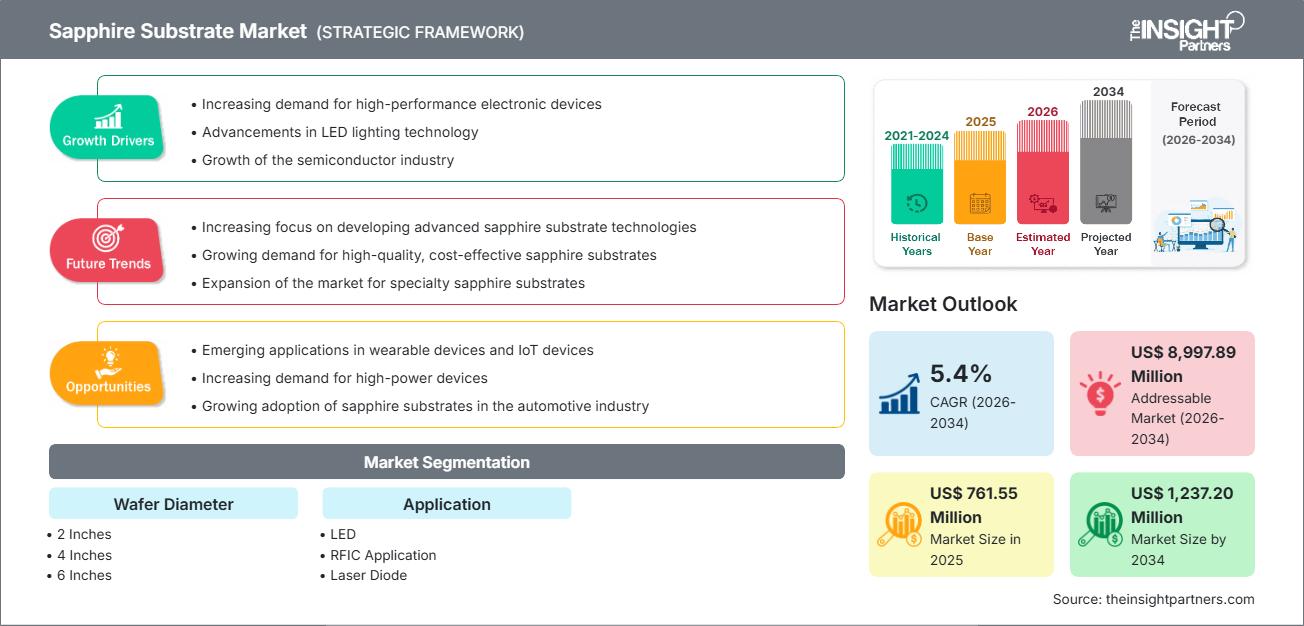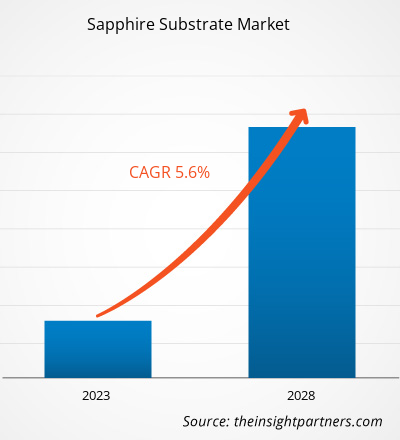Si prevede che il mercato globale dei substrati in zaffiro raggiungerà i 1.237,20 milioni di dollari nel 2034, rispetto ai 761,55 milioni di dollari del 2025. Ciò rappresenta un CAGR del 5,4% nel periodo 2026-2034.
Analisi del mercato del substrato di zaffiro
Diverse tendenze strutturali e cambiamenti nella domanda di utilizzo finale sostengono la crescita prevista del mercato dei substrati di zaffiro:
- La crescente adozione di tecnologie di illuminazione a risparmio energetico e LED in tutto il mondo sta incrementando la domanda di substrati in zaffiro come materiali di base per wafer e dispositivi LED.
- L'espansione della produzione di semiconduttori e optoelettronici, in particolare per applicazioni ad alte prestazioni, sta determinando una domanda di substrati grazie alle superiori proprietà di isolamento termico, ottico ed elettrico dello zaffiro.
- I progressi nelle tecniche di crescita dei cristalli e di produzione dei wafer consentono di realizzare wafer di zaffiro di diametro maggiore, migliorando la resa e l'efficienza dei costi, il che ne incentiva un'adozione più ampia in tutti i settori.
- Il passaggio alla miniaturizzazione nell'elettronica, il crescente utilizzo di dispositivi ad alta frequenza (ad esempio, circuiti integrati RF, optoelettronica, diodi laser) e la crescente domanda nei settori automobilistico e delle telecomunicazioni ampliano ulteriormente il mercato a cui rivolgersi.
Panoramica del mercato dei substrati di zaffiro
I substrati in zaffiro sono wafer di ossido di alluminio (Al₂O₃) monocristallino o policristallino ad alta purezza, utilizzati come base in numerose applicazioni, principalmente in LED, circuiti integrati RF, diodi laser, dispositivi optoelettronici e semiconduttori di potenza/ad alta frequenza. Grazie alla loro eccellente conduttività termica, all'isolamento elettrico, alla stabilità chimica e alla trasparenza ottica, i substrati in zaffiro consentono la fabbricazione di componenti elettronici e di illuminazione ad alte prestazioni e durevoli. Pertanto, rappresentano input chiave per i settori in cui è richiesta affidabilità contro stress termici, alte frequenze o elevate prestazioni ottico/elettriche.
I substrati in zaffiro semplificano sicuramente la produzione di dispositivi, ne migliorano le prestazioni, come la dissipazione termica o l'integrità del segnale, e supportano la scalabilità all'aumentare del diametro dei wafer, insieme alla complessità del dispositivo. Il materiale funge quindi da substrato portante per applicazioni che spaziano dall'illuminazione generale, all'elettronica di consumo e alle telecomunicazioni, fino all'automotive e all'industria, dai piccoli LED ai dispositivi RF/ottici avanzati.
Personalizza questo report in base alle tue esigenze
Riceverai la personalizzazione gratuita di qualsiasi report, incluse parti di questo report, analisi a livello nazionale, pacchetto dati Excel e potrai usufruire di fantastiche offerte e sconti per start-up e università.
Mercato dei substrati di zaffiro: approfondimenti strategici

- Scopri le principali tendenze di mercato di questo rapporto.Questo campione GRATUITO includerà analisi dei dati, che spaziano dalle tendenze di mercato alle stime e alle previsioni.
Mercato, fattori trainanti e opportunità del substrato di zaffiro
Fattori trainanti del mercato
- Crescente domanda di LED e adozione di sistemi di illuminazione a basso consumo energetico: con la crescente diffusione dell'illuminazione a LED a livello globale, i substrati in zaffiro restano i substrati preferiti per la fabbricazione di wafer LED.
- Crescita dei settori dei semiconduttori, dell'optoelettronica e delle radiofrequenze: la necessità di substrati ad alte prestazioni, termicamente stabili ed elettricamente isolanti nelle applicazioni dei semiconduttori e della fotonica alimenta la domanda di substrati in zaffiro.
- Progressi nelle tecniche di produzione dei wafer: i miglioramenti nella crescita dei cristalli, la produzione di wafer di diametro maggiore e i migliori tassi di resa rendono i substrati di zaffiro più economicamente sostenibili per una varietà di applicazioni.
- Miniaturizzazione e diversificazione delle applicazioni finali: la crescente domanda da parte dei settori dell'elettronica di consumo, dell'automotive (illuminazione a LED, sensori), delle telecomunicazioni (5G, dispositivi RF) e dell'elettronica industriale favorisce un'adozione più ampia.
Opportunità di mercato
- Utilizzo crescente nei mercati emergenti e nei nuovi settori verticali: con l'espansione a livello globale dei mercati dell'elettronica di consumo, dell'elettronica per autoveicoli e delle tecnologie rinnovabili/verdi (in particolare nella regione Asia-Pacifico), è probabile che la domanda di substrati in zaffiro cresca in modo sostanziale.
- Adozione di tecnologie di illuminazione e visualizzazione di nuova generazione: la crescita dei micro-LED, mini-LED e dei display ad alte prestazioni crea una nuova domanda di substrati in zaffiro di alta qualità.
- Integrazione nei settori dei semiconduttori e della fotonica per applicazioni ad alta frequenza e alta potenza: le proprietà termiche ed elettriche dello zaffiro lo rendono ideale per dispositivi di potenza, componenti RF/5G, diodi laser e optoelettronica.
- Opportunità di ridimensionamento delle dimensioni dei wafer e di ottimizzazione dei costi: i wafer in zaffiro di diametro maggiore e le rese di produzione migliorate contribuiscono a ridurre il costo unitario, rendendo i substrati in zaffiro competitivi anche per applicazioni sensibili ai costi.
Analisi della segmentazione del mercato dei substrati di zaffiro
Per diametro del wafer
- 2 pollici
- 4 pollici
- 6 pollici
Per applicazione
- GUIDATO
- Applicazione RFIC
- Diodo laser
- Circuito integrato in silicio su zaffiro
Per geografia
- America del Nord
- Europa
- Asia-Pacifico
- America Latina / Medio Oriente e Africa (LAMEA) / Resto del mondo
Approfondimenti regionali sul mercato dei substrati di zaffiro
Le tendenze e i fattori regionali che hanno influenzato il mercato dei substrati di zaffiro durante il periodo di previsione sono stati ampiamente spiegati dagli analisti di The Insight Partners. Questa sezione illustra anche i segmenti e la distribuzione geografica del mercato dei substrati di zaffiro in Nord America, Europa, Asia-Pacifico, Medio Oriente e Africa, America Meridionale e Centrale.
Ambito del rapporto di mercato del substrato di zaffiro
| Attributo del report | Dettagli |
|---|---|
| Dimensioni del mercato nel 2025 | 761,55 milioni di dollari USA |
| Dimensioni del mercato entro il 2034 | 1.237,20 milioni di dollari USA |
| CAGR globale (2026 - 2034) | 5,4% |
| Dati storici | 2021-2024 |
| Periodo di previsione | 2026-2034 |
| Segmenti coperti | Per diametro del wafer
|
| Regioni e paesi coperti | America del Nord
|
| Leader di mercato e profili aziendali chiave |
|
Densità degli attori del mercato del substrato di zaffiro: comprendere il suo impatto sulle dinamiche aziendali
Il mercato dei substrati in zaffiro è in rapida crescita, trainato dalla crescente domanda degli utenti finali, dovuta a fattori quali l'evoluzione delle preferenze dei consumatori, i progressi tecnologici e una maggiore consapevolezza dei vantaggi del prodotto. Con l'aumento della domanda, le aziende stanno ampliando la propria offerta, innovando per soddisfare le esigenze dei consumatori e sfruttando le tendenze emergenti, alimentando ulteriormente la crescita del mercato.

- Ottieni una panoramica dei principali attori del mercato dei substrati di zaffiro
Analisi delle quote di mercato del substrato di zaffiro per area geografica
- Nord America: nel 2024, il Nord America rimane una regione leader grazie alla forte presenza di produttori di semiconduttori, aziende di LED e aziende di elettronica high-tech.
- Asia-Pacifico: si prevede che registrerà il tasso di crescita più rapido nel periodo di previsione, grazie al boom della produzione di LED, all'aumento della produzione di semiconduttori ed elettronica di consumo e alla crescente domanda da parte dei settori automobilistico e delle telecomunicazioni, soprattutto in paesi come Cina, Giappone, Corea del Sud e nei mercati emergenti.
- Europa: un mercato stabile e in crescita moderata, trainato dalla domanda di illuminazione a risparmio energetico, tecnologie verdi e applicazioni di semiconduttori/optoelettronici nei segmenti industriale e dei consumatori.
- LAMEA (America Latina, Medio Oriente e Africa): rappresenta una frontiera emergente con potenziale, in particolare nell'adozione dell'illuminazione a LED, nell'energia rinnovabile (solare) e nell'espansione delle telecomunicazioni, sebbene l'adozione attuale rimanga limitata rispetto ad altre regioni.
Mercato del substrato di zaffiro, densità dei giocatori: comprendere il suo impatto sulle dinamiche aziendali
Il panorama competitivo del mercato dei substrati in zaffiro rimane frammentato o moderatamente consolidato. Sebbene alcuni dei principali attori dominino le posizioni di leadership a livello globale nel mercato, in alcune aree geografiche prevalgono diversi attori regionali e di nicchia. Questo scenario competitivo influisce su comportamenti strategici quali:
- Ridurre i costi per substrato concentrandosi sulla scalabilità delle dimensioni dei wafer e migliorando l'efficienza della resa.
- PSS: differenziazione attraverso substrati modellati, substrati speciali per applicazioni di fascia alta, come RF, optoelettronica e fotonica.
- Investimenti in tecnologie di crescita e finitura dei cristalli che garantiscono solo wafer di grande diametro, con la massima purezza e il minimo di difetti.
- Espansione geografica/aumento della capacità produttiva per soddisfare la domanda nelle regioni ad alta crescita, in particolare nell'area Asia-Pacifico.
Aziende chiave che operano nel mercato dei substrati di zaffiro
- Iljin Display Co. Ltd.
- Kyocera Corporation
- Meller Optics, Inc.
- Monocristallo
- Rubicon Technology Inc.
- Cryscore Optoelectronic Limited
- Precision Micro-Optics Inc.
- Saint-Gobain SA
- Semiconductor Wafer Inc.
Altre aziende analizzate nel corso della ricerca:
- HC SemiTek
- Fujian Jingan Optoelectronics Co., Ltd.
- Yunnan Crystaland Technology Co., Ltd.
- TDG Holding Co., Ltd.
- Gavish
Mercato, notizie e sviluppi recenti del substrato di zaffiro
- Secondo l'ultimo rapporto di The Insight Partners, la crescente tendenza all'utilizzo di wafer e substrati LED di grande diametro è considerata uno dei principali fattori che dovrebbero dare impulso al mercato.
- I progressi nella produzione hanno portato diverse aziende a sviluppare substrati in zaffiro modellato (PSS), che migliorano l'efficienza di estrazione della luce, aspetto particolarmente importante per i LED ad alta luminosità e le tecnologie di visualizzazione di nuova generazione.
- Alcuni importanti produttori di substrati stanno investendo in wafer di diametro maggiore e in processi di crescita dei cristalli migliorati per soddisfare la domanda di LED, semiconduttori di potenza e applicazioni di telecomunicazioni, segnalando uno spostamento strategico verso la scalabilità e la diversificazione delle applicazioni.
- La crescente domanda da parte di settori quali l'automotive (illuminazione a LED, sensori), le telecomunicazioni (componenti 5G/RF) e l'optoelettronica sta ampliando la base di utilizzo finale oltre la tradizionale illuminazione a LED, contribuendo all'espansione del mercato.
Mercato del substrato di zaffiro, copertura del rapporto e risultati finali
L'ipotetico rapporto "Sapphire Substrate Market – Forecast (2021-2034)" fornirebbe:
- Dimensioni e previsioni del mercato globale (in valore) a livello globale, regionale e nazionale per tutti i segmenti di mercato chiave (tipo di prodotto, applicazione, utente finale, regione).
- Analisi delle dinamiche di mercato: fattori trainanti, vincoli, opportunità di crescita e sviluppi recenti.
- Analisi dettagliata della segmentazione in base al tipo di prodotto, all'applicazione, all'utente finale e all'area geografica.
- Panorama competitivo: principali attori, concentrazione del mercato, piccoli fornitori regionali o di nicchia e loro posizionamento strategico.
- Tendenze nella produzione: crescita delle dimensioni dei wafer, tecnologie di produzione, miglioramenti della resa e adozione di substrati modellati.
- Previsioni fino al 2028 (anno di base 2022), compresi i tassi di crescita regionali e le aree di applicazione emergenti.
- Analisi storica (2 anni), anno base, previsione (7 anni) con CAGR
- Analisi PEST e SWOT
- Valore/volume delle dimensioni del mercato - Globale, Regionale, Nazionale
- Industria e panorama competitivo
- Set di dati Excel
Report recenti
Testimonianze
Motivo dell'acquisto
- Processo decisionale informato
- Comprensione delle dinamiche di mercato
- Analisi competitiva
- Analisi dei clienti
- Previsioni di mercato
- Mitigazione del rischio
- Pianificazione strategica
- Giustificazione degli investimenti
- Identificazione dei mercati emergenti
- Miglioramento delle strategie di marketing
- Aumento dell'efficienza operativa
- Allineamento alle tendenze normative




















 Ottieni un campione gratuito per - Mercato del substrato di zaffiro
Ottieni un campione gratuito per - Mercato del substrato di zaffiro